Have you ever noticed the word “Monticello” printed on the label of your favorite Virginia wine? “Christ,” you probably thought, “is there anything around here that man hasn’t gotten his clutches on?” Well, no, but the use of “Monticello” on the label does not mean that the wine is made at TJ’s house. Monticello is the name of an American Viticultural Area, and it does tell you something about where the wine comes from: 800,000 acres covering most of Albemarle, Greene, Orange, and Nelson counties. Only, it should tell you more.
AVAs are the American version of the legally defined wine regions, or appellations, commonly used in Europe. If an area is seen as producing wine that is unique, it can be designated a specific appellation. In Europe, this means rules governing things like what grapes are used or how the wine is aged. If a wine meets those standards, the winery is allowed to use the appellation name on its label. Rioja, Chablis and Chianti are all appellation names, acting as a guarantee of quality for the consumer and a marketing tool for the winemaker.
American Viticultural Areas have no such requirements. All an AVA tells you is that at least 85 percent of the grapes were grown within the AVA. That many Americans ignore this part of the label is unfortunate, for at its best, the appellation system combats homogeneity in wine by placing the emphasis on the qualities that make a wine unique, such as climate, topography, and soil, instead of the one thing it shares with thousands of other wines, namely the grape from which it’s made.
Virginia has six AVAs, but “Monticello” is the only one used on labels with any regularity, and it’s not because wine drinkers seek out the taste imparted by our granite-based clay soil. It’s because we were lucky enough to be able to name our AVA after a well-known tourist attraction.
It’s time for the Virginia wine industry as a whole to re-evaluate our AVAs. Most of them were created over 20 years ago, at a time when winemakers were still trying to figure out which end of a barrel was up. Only now, after 30 years of winemaking, are we beginning to grasp the uniqueness of our state’s growing areas.
Proper use of AVAs would encourage vineyards to be planted where the grapes grow best instead of where they look best, and our wines to be sold by what differentiates them instead of what makes them seemingly the same—“here’s another Chardonnay.” But first consumers have to know the AVAs, winemakers have to use them, and the AVAs themselves have to make sense. The Rocky Knob AVA is home to two wineries, but you won’t see the name on their labels, because they don’t use the area as their prime source of grapes. Meanwhile, Northern Virginia, home to many of our best wineries, has no AVAs.
Imagine how the seven winemakers who reside in the tragically titled “Northern Neck George Washington Birthplace AVA” feel. They’re desperately wishing it were named “Mt. Vernon.”





